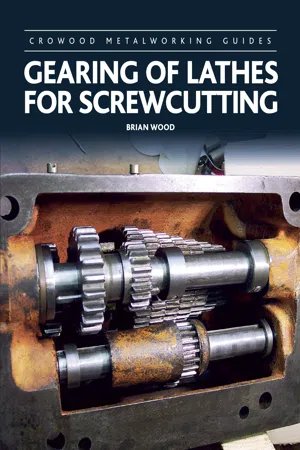
eBook - ePub
Gearing of Lathes for Screwcutting
Brian Wood
This is a test
- 300 pages
- English
- ePUB (mobile friendly)
- Available on iOS & Android
eBook - ePub
Gearing of Lathes for Screwcutting
Brian Wood
Book details
Book preview
Table of contents
Citations
About This Book
Gearing of Lathes for Screwcutting is aimed specifically at the engineer for use in the workshop. It is intended to take away as much as possible of the mathematics and mystique from calculating gear ratios, so that the more enjoyable work of using your lathe to make things becomes as easy as possible. Topics covered in this latest addition to the Crowood Metalworking Guides include Myford and other types of lathes; approximations and alternatives; errors and their significance and the non-gearbox mini-lathe. Fully illustrated with 102 colour photographs.
Frequently asked questions
How do I cancel my subscription?
Can/how do I download books?
At the moment all of our mobile-responsive ePub books are available to download via the app. Most of our PDFs are also available to download and we're working on making the final remaining ones downloadable now. Learn more here.
What is the difference between the pricing plans?
Both plans give you full access to the library and all of Perlego’s features. The only differences are the price and subscription period: With the annual plan you’ll save around 30% compared to 12 months on the monthly plan.
What is Perlego?
We are an online textbook subscription service, where you can get access to an entire online library for less than the price of a single book per month. With over 1 million books across 1000+ topics, we’ve got you covered! Learn more here.
Do you support text-to-speech?
Look out for the read-aloud symbol on your next book to see if you can listen to it. The read-aloud tool reads text aloud for you, highlighting the text as it is being read. You can pause it, speed it up and slow it down. Learn more here.
Is Gearing of Lathes for Screwcutting an online PDF/ePUB?
Yes, you can access Gearing of Lathes for Screwcutting by Brian Wood in PDF and/or ePUB format, as well as other popular books in Technik & Maschinenbau & Technische & produzierende Gewerbe. We have over one million books available in our catalogue for you to explore.
Information

1The Myford ML7 and Variants
This chapter is applicable to the Myford ML7, Super 7 and variants, with the Myford English gearbox and the North American export version. (The David Machin gearbox will be dealt with in Chapter 2.) In both these chapters you will find a discussion of how a gearbox works in general, which will also give insight into all of them.
THE TABLES
From Table 1 it is quite gratifying to see how many different applications are possible from the majority of the wheels listed. That advantage begins to fade from roughly 40 teeth onwards, however, and single use wheels begin to dominate. The limitations of the gearbox internal selections begin to show in these cases, as the ratio steps it provides do not blend well enough with single tooth change wheel adjustments for satisfactory matching in the coarser pitches. Nevertheless, the choices are listed as potential solutions, without regard to the provision of the necessary wheels to make them work as intended.
What is completely different is that these are now single wheel changes, and after fitting the wheel it just needs the quadrant to be swung back up into mesh, select the corresponding gearbox setting from the table and the lathe is then geared to cut the chosen pitch. The fine feed machining capability is of course still available. Operational convenience, and speed for those to whom it is important, have been greatly improved as a result. The need for quadrant changes, fiddly wheel meshing and depthing of an array of change wheels is all completely absent.
Rules for selection
I have been very mindful of the fact that not all of these tables will be of direct interest to everyone. Owners and users are of course at liberty to select what they need to suit their own interests and requirements. The tables are presented to show, convincingly it is hoped, that all these possibilities now exist. Because of these concerns, every effort has been made to limit the number of wheels that are needed by adopting two basic selection rules:
Rule 1 was set by choosing realistic expectations of the outcome within error limits in a range of plus or minus 13 microns (just over 0.001 inches in total).
Rule 2 was governed by maximizing the efficient use of wheels to provide as many working applications from each wheel as possible.
When the calculations showed that a choice became possible to produce a given pitch, within the constraints of Rule 1, of which one gave the more accurate result, Rule 2 was used to make the selection. The objective was then based on the greater usefulness, not precision per se.
In cases where both results satisfied Rule 2 as well, then both the choices have been listed so that users can make the final selection for themselves. This will depend entirely on which wheels they may have available, or wish to add to their collection.
Only when the calculations showed there were no other possible arrangements which gave the pitch required was the single wheel use included. Where a limitation of this kind occurs, the individual cases have been highlighted in the table concerned. In some of these situations, the Rule 1 criterion was unavoidably exceeded and due attention has accordingly been drawn to the larger error that is involved. They have bee...
Table of contents
- Cover Page
- Title Page
- Copyright Page
- Dedication
- Contents
- Introduction
- Part 1 The Gearbox Lathes
- Part 2 The Non-Gearbox Mini Lathe
- References
- Acknowledgements
- Index